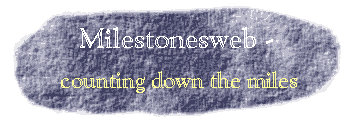

 Rushing past them at speeds undreamt of by the people
who erected them, we pass these silent sentinels of earlier ages without much thought. We
retain a fondness for these early markers by declaring any definitive waypoint as a
'milestone' in anything from a business process to the passage of history. This site is a
tribute to the real thing - milestones were essential waypoints in times when maps were
rare and travel was but foot or horse. There were no mileometers to count down the miles
to the destination, and the milestones were reassurance that the traveller was on the
right path and getting closer to where he was going..
Rushing past them at speeds undreamt of by the people
who erected them, we pass these silent sentinels of earlier ages without much thought. We
retain a fondness for these early markers by declaring any definitive waypoint as a
'milestone' in anything from a business process to the passage of history. This site is a
tribute to the real thing - milestones were essential waypoints in times when maps were
rare and travel was but foot or horse. There were no mileometers to count down the miles
to the destination, and the milestones were reassurance that the traveller was on the
right path and getting closer to where he was going..
It was those master-road-builders, the Romans, who first defined the centre of Imperial Rome with the 'Golden Milestone' and placed milestones on their roads showing the distance to this datum so travellers could mark their progress. No road construction could stand up to the thousand years of neglect and decline that followed, and long-distance travel on the King's Highway became an arduous task undertaken by few. In the more remote parts of Britain such as the Peak District and the Yorkshire moors, travellers often perished as they became lost without features to orient themselves, and to arrest this needless loss of life William III decreed that guide stones be erected in such regions.
 Later in the 16th century the advent of the Royal Mail with staging points
focused attention on the roads again. The post riders had to make good time, specified
clearly, and milestones came into their own again to measure progress. One of the earliest
roads with milestones from this time is the Cambridge to Barkway road which was the start
of the coach road to London. Surveyed by a Cambridge professor, most of this Trinity Hall series still stands on the B1368.
Later in the 16th century the advent of the Royal Mail with staging points
focused attention on the roads again. The post riders had to make good time, specified
clearly, and milestones came into their own again to measure progress. One of the earliest
roads with milestones from this time is the Cambridge to Barkway road which was the start
of the coach road to London. Surveyed by a Cambridge professor, most of this Trinity Hall series still stands on the B1368.
There were still problems because responsibility for maintaining the roads fell to the local parish, which had to supply the King with the work of several able-bodied men for a few days a year, and nominate a surveyor to determine when work was necessary. This was not a satisfactory solution for the increasing demands made of the roads, and in the 18th and 19th centuries turnpike trusts were established that used the revenue from the tolls paid by travellers to maintain the roads. They flourished until the advent of the railways from 1830 onwards, which offered a much faster and more comfortable alternative. The next period of road construction was the post-war era to serve the motor car.
Turnpike trusts erected many of the milestones that are still part of our roads today, and they were made in many shapes, forms and methods of construction. Placed during the the times of the pedestrian, the carriage, and the bicycle, the milestone has a fascinating story to tell of how our roads came to be. Because they were often locally produced and there was no standard design, milestones come in a fabulous range of types and designs, each route and region with its own character. I have specialised in Suffolk but the gazetteer has sites from all over the UK.
Milestone Gazetteer by county |
milestone designs
books on
milestones | links